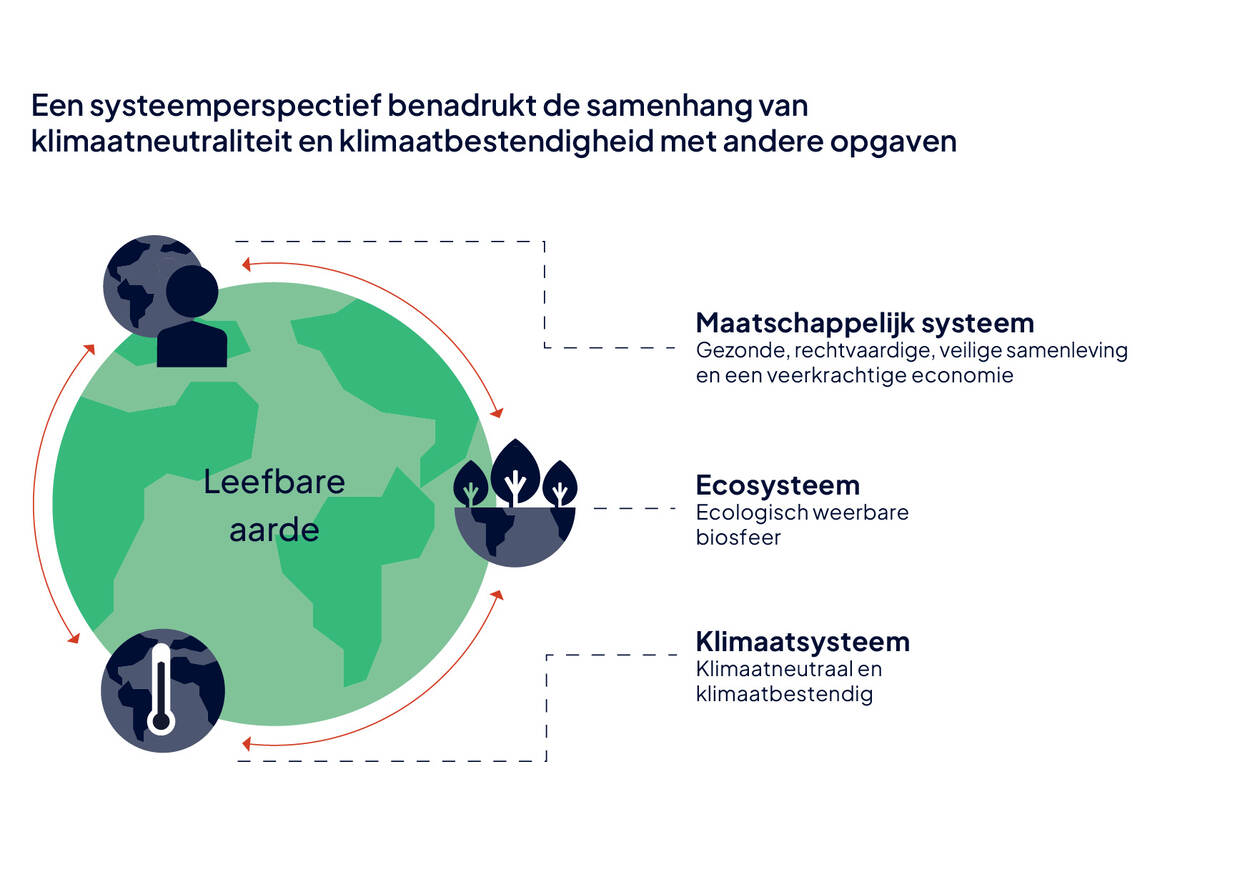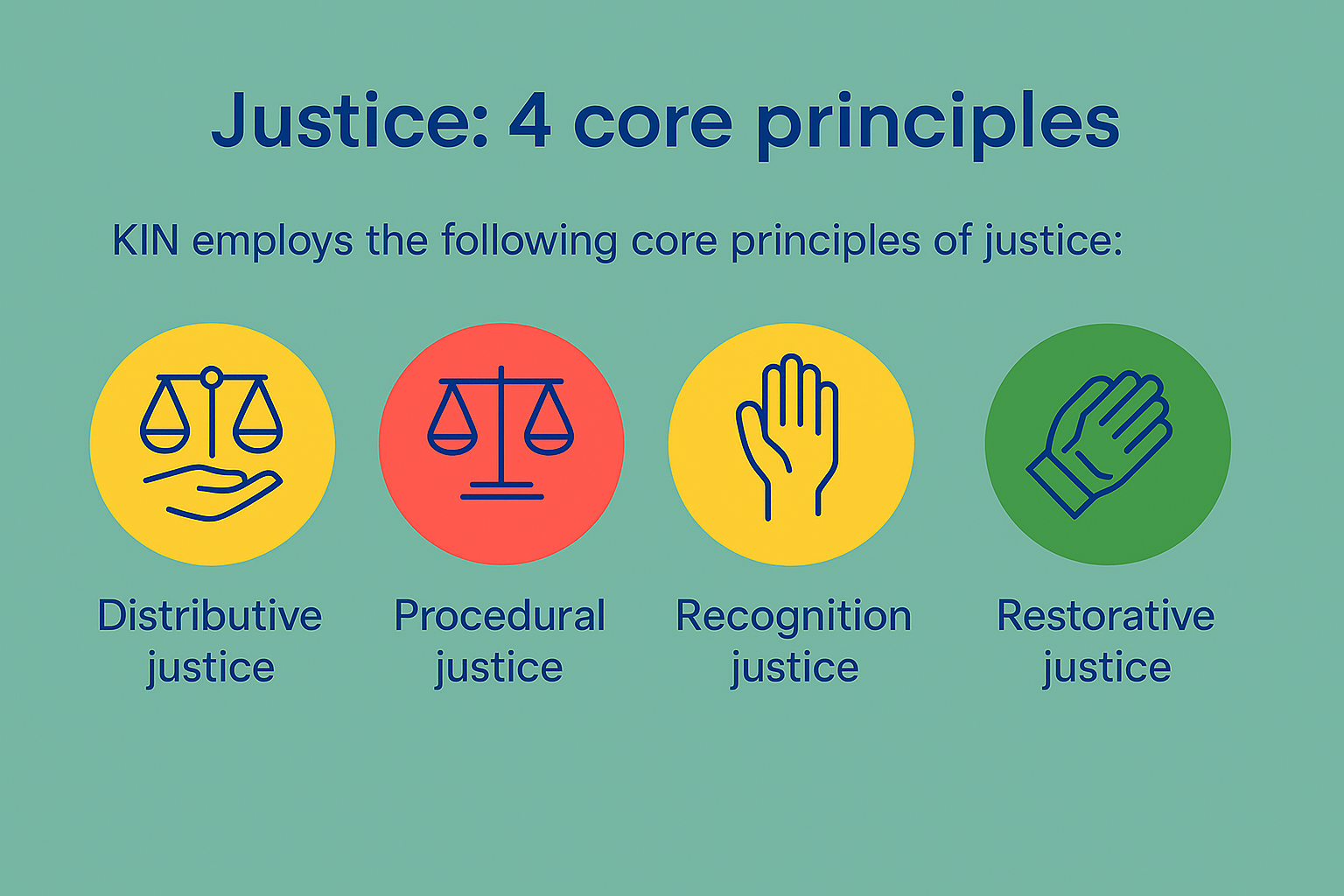Our vision on Climate Justice
KIN works to accelerate transitions to a just, climate-neutral and climate-resilient society from a systemic perspective. We also always take climate justice into account when developing our programmes and projects.

The systemic lens
At KIN, we take a systemic approach. By this we mean a way of observing, researching and reasoning that considers a social (sub)system as a whole, with all the different processes, circumstances and actors that are part of it. This is because different elements within a system must change in order for the system as a whole to change.
A systemic lens sees the necessary climate transitions as much more than technological improvements such as more efficient energy generation. Ingrained structures, cultures and working methods relating to, for example, legislation, behaviour and finance must also change.
How can you apply climate justice to your work?
How can you, as a climate worker or researcher, incorporate the perspective of justice into your climate challenge(s)? The simple answer to that is: make the climate justice perspective a standard part of your way of looking and acting. So that this is always included in all processes, decisions, and measures.
At the KIN, we have developed a ‘decision-making framework’ with a number of questions that can help you on your way to concretely applying climate justice to make it a standard part of your climate challenge(s).

Inequality of opportunity
The inequalities within the Kingdom of the Netherlands are already considerable. People with low incomes live on average 21 years less in ‘good experienced health’ than people with high incomes. Men with low incomes live on average 8.8 years shorter, women 7.1 years. (Pharos 2025).
Education, health, work and housing are unequally distributed, and this inequality begins at birth (G4 proposal on inequity). Climate change and measures against it can either strengthen or reduce these inequalities, depending on how justice is incorporated into policy and implementation.


How do we define climate justice?
The definition below, is based on analyses of scientific literature and policy documents and has been refined through conversations with researchers, policymakers, climate professionals and residents who are committed to a just climate transition. It provides direction for climate workers and researchers to make conscious choices regarding climate justice.
KIN does not see climate justice as the endpoint, but as a direction. The goal is not to achieve perfect justice, but to reduce unwanted inequalities and prevent climate transitions from widening the gap.
“Climate justice ensures fairness in avoiding, addressing, and repairing the causes and consequences of climate change, biodiversity loss, and ecological breakdown. This must occur through an inclusive process that considers the interests, needs, risks, capabilities, power relations, opportunities, and limitations of all —both human and non-human— across time: past, present, and future.”
Source: KIN ACT-programme, WP1.
Justice principles
KIN employs 4 core principles of justice:
1. Distributive justice
Fairly distributing material resources and rights, such as money and space. This can be done based on:
– The greatest social benefit
– Individual rights and freedoms
– Capacity and solidarity
– Contribution and benefit
Source: WRR rapport ´Rechtvaardigheid in klimaatbeleid’.
2. Procedural justice
The extent to which all stakeholders in a process are involved in a fair manner. This not only strengthens the fairness of outcomes, but also trust and engagement.
3. Recognition justice
Respect and appreciation for everyone’s dignity, identity, culture and rights of all involved, including non-human entities. This helps create an inclusive society where people feel seen, heard and valued, regardless of their background.
4. Restorative justice
Fair distribution of the costs and consequences of climate damage, taking into account historical responsibility from, for example, the colonial past.
Action lines: Providing basis, redistribution and customization
To put these principles into practice, they have been translated into three action lines so that climate workers or researchers can apply this more concretely:
1. Providing basis
Offering a minimum foundation that is of sufficient quality for everyone. This is a primary task of government.
2. Redistribute, counter-steer and limit
Intervening where the ‘luxury’ of one comes at the expense of another.
3. Providing customization
Offering something more or different so that everyone has a fair chance. Everyone with the same talents has an equal chance at development and thus the same outcomes.
Source: Raamwerk kansengelijkheid gemeente Utrecht

Equality, equity, justice
This approach is well illustrated by the distinction between equality, equity and justice. Equal treatment (equality) can maintain or even increase existing inequalities. Adapting systems to promote justice (justice) and customization or targeted redistribution, counter-steering or limitation (equity) reduce inequalities.
Climate workers or researchers can use this climate justice perspective as a guide for policy, research and practice. They can make just choices for structural changes in ways of thinking and working through dialogue. This can sometimes provoke resistance within existing systems. Therefore, climate justice is not only a goal, but also a transition in itself.
How can you apply climate justice to your work?
How can you, as a climate worker or researcher, incorporate the perspective of justice into your climate challenge(s)? The simple answer to that is: make the climate justice perspective a standard part of your way of looking and acting. So that this is always included in all processes, decisions, and measures.
At the KIN, we have developed a ‘decision-making framework’ with a number of questions that can help you on your way to concretely applying climate justice to make it a standard part of your climate challenge(s).


